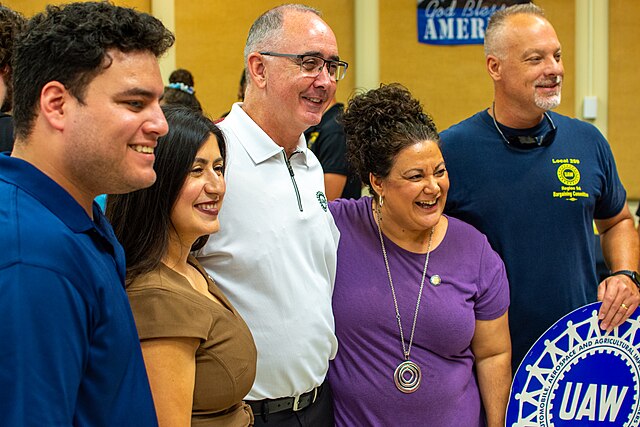This article first appeared in our weekly Hackwatch newsletter on media accountability. Subscribe here to get it delivered straight to your inbox every week, and check out our Hackwatch website.
In this week’s Hack Watch, we look back at some of the worst coverage the United Auto Workers (UAW) endured while fighting for improved working conditions, higher wages, and stronger benefits. From Steve Ratner to Jim Cramer, media figures (and industry officials) maligned the union and the “boss” Shawn “Hurricane” Fain. Now the strike is over, it’s time we really take a look at some of the terrible coverage the strikes got.
What UAW Got
Since the union fought tirelessly through collective action (strikes), smart bargaining tactics, and a keen coordinated communications strategy, the union was offered solid (tentative) agreements from each of the big three automakers. Some of the benefits included in the General Motors (GM) deal with the union include: an 11% initial wage increase, reinstated cost-of-living adjustments, allowing for top wages in three years (rather than eight), and finally protection of workers’ right to strike over plant closures. The COLA restoration, a major win for the union, is particularly significant because it had been forfeited in the Great Recession as a concession for GM to accept the government bailout. Ford and Stellantis also offered similar benefits including COLA restoration, higher wages, and an end to tiered wages. Clearly the union is coming away from the strike stronger, and better for it.
How “Hurricane Fain” Came To Be
Fain came to lead UAW as a result of frustration with previously feckless leadership from the top. He felt the union made far too many concessions during the 2000s financial crisis so the big three would be bailed out of the federal government. Then came the bombshell report that top brass in the union had been embezzling funds that led two former UAW presidents to be charged, convicted, and sentenced to 57 months prison. Fain came into the presidency as a reformist, who not only wanted to end corruption, but ensure that union members were given fair compensation and benefits for the work that they do.
It’s not surprising that autoworkers embraced Fain. As Bloomberg notes, “The UAW’s aggressiveness in many ways reflects the more assertive mood of the American worker, who’s anxious about job security in the age of artificial intelligence and angry about an ever-growing wealth gap.” Workers are afraid of unemployment, stagnant wages, poor benefits, and more. At the end of the day, this strike has been about workers wanting to reap the benefits of the strong earnings they helped create for the automakers.
The Media’s Response To Fain Has Been Less Than Stellar
Despite the fact that polling indicated that the strike was popular among Americans, the ,edia breathlessly reported semi- apocalyptic pieces describing Fain as “fiery,” “aggressive,” “militant,” “unlikely and outspoken,” “a bulldog,” and of course, as Bloomberg dubbed the man, “Hurricane Fain.” Heck, Bloomberg questioned, “What Do Striking Auto Workers Really Want?” in their newsletter, stating, “Detroit automakers survived a pandemic and semiconductor shortage. They were embracing a historic transition to the electric-vehicle era, underwritten by billions in subsidies from the Biden administration. Profits were rolling in. Then came Hurricane Fain.” Imagine believing that wanting good wages and COLA restoration was somehow a bad thing. Or that the person elected by auto workers might have a platform that appealed to them! (Or that what workers wanted was difficult to discern despite the existence of a written platform and concrete bargaining demands!)
And who could forget CNBC’s Jim Cramer, who compared Fain to communist Leon Trotsky because Fain wanted to end the two-tiered system whereby wages were disbursed inequitably based on seniority?
Despite all of the bad coverage and the mystifying misreading of Fain and workers in general, the union won. Journalists should be asking themselves whether their content would have allowed their readers to come to see this reality as likely; if not, what better sources should they cultivate in the future and which ones should they disdain?
Protecting The Civil Service
On September 15, the Biden Administration announced a Proposed Rule that would strengthen protections for nonpartisan civil servants across the country. The federal employees who make up the civil service are meant to serve the American people, not politicians—the Biden administration’s changes will help protect the civil service’s ability to fulfill that mission. More details about the proposal are available here.
Democracy Forward is hosting an educational webinar on Tuesday, November 7, 2023 at 1:00 PM ET on Zoom. Join the webinar to learn more about the Proposed Rule, why your organization should consider commenting, and the tools available to you (including a template comment-available here). You can register for the webinar here.
Image Credit: “UAW President Shawn Fein with NYS Elected Officials & UAW Region 9A Reps” by InformedImages is licensed under CC BY-SA 4.0.

